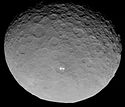Yalode (crater)
 An image of Yalode and surrounding regions. Yalode is heavily degraded, only barely discernible as a flattened region at the bottom-center of the image | |
| Feature type | Impact crater |
|---|---|
| Location | Yalode Quadrangle, Ceres |
| Coordinates | 42°35′S 292°29′E / 42.58°S 292.48°E[1] |
| Diameter | 271 km |
| Discoverer | Dawn |
| Eponym | Yalodé |
Yalode (/jəˈloʊdi/)[2] is the second-largest confirmed crater on Ceres, after Kerwan. It is adjacent to another large crater, Urvara and serves as the namesake for the Yalode Quadrange.[3] Yalode named after the Dahomeyan (Fon) deity of the yam harvest, Yalodé; the name Yalode was officially approved by the International Astronomical Union (IAU) on 3 July 2015.[1]
Geology[edit]
Yalode is a heavily degraded impact basin, hosting numerous smaller craters such as Besua. Yalode is geologically homogeneous, with its interior compositionally similar to surrounding areas.[3] Yalode is itself superimposed by the Urvara basin, the third-largest crater on Ceres; both are surrounded by extensive ejecta deposits.[4]
Yalode and the regions surrounding it appear to be heavily tectonized. The floor of Yalode basin features parallel fractures that are larger and more developed than those found in other large impact basins on Ceres. The fractures in Yalode appear to have formed in at least two distinct generations and are concentrated along its basin rim. The parallel nature of the fractures are possibly representative of horst and graben faulting from extensional stresses and tilted crust blocks.[5] Surrounding Yalode is a network of pit chains, Samhain Catenae. The pit chains of Samhain Catenae are oriented roughly radially to Yalode. Despite this, Samhain Catenae does not appear to be created by ejecta thrown out from the impact event that created Yalode (the mechanism which the radial crater chains of Mare Orientale were formed). Instead, Samhain Catenae may be a network of extensional faults, created as material below Yalode upwelled. This process would also explain the unusually wide nature of Yalode's interior floor fractures.[6][5]
See also[edit]
- List of geological features on Ceres
- Dawn (spacecraft), the spacecraft used to discover Yalode crater
References[edit]
- ^ a b "Yalode". Gazetteer of Planetary Nomenclature. USGS Astrogeology Research Program. (Center Latitude: -42.58°, Center Longitude: 292.48°)
- ^ "5". ac.arc.nasa.gov. Archived from the original on 7 January 2017. Retrieved 13 January 2022.
- ^ a b Longobardo, A.; Galiano, A.; Ammannito, E.; et al. (January 2019). "Mineralogy of the Urvara-Yalode region on Ceres". Icarus. 318: 241–250. Bibcode:2019Icar..318..241L. doi:10.1016/j.icarus.2017.12.011.
- ^ Scully, Jennifer E. C.; Russell, Christopher T.; Castillo-Rogez, Julie C.; Raymond, Carol A.; Ermakov, Anton I. (March 2019). "Introduction to the special issue: The formation and evolution of Ceres' Occator crater". Icarus. 320: 1–6. Bibcode:2019Icar..320....1S. doi:10.1016/j.icarus.2018.02.029.
- ^ a b Krohn, K.; von der Gathen, I.; Buczkowski, D. L.; et al. (August 2020). "Fracture geometry and statistics of Ceres' floor fractures". Planetary and Space Science. 187. Bibcode:2020P&SS..18704955K. doi:10.1016/j.pss.2020.104955.
- ^ Scully, J. E. C.; Buczkowski, D. L.; Schmedermann, N.; et al. (October 2017). "Evidence for the Interior Evolution of Ceres from Geologic Analysis of Fractures". Geophysical Research Letters. 44 (19): 9564–9572. Bibcode:2017GeoRL..44.9564S. doi:10.1002/2017GL075086.


